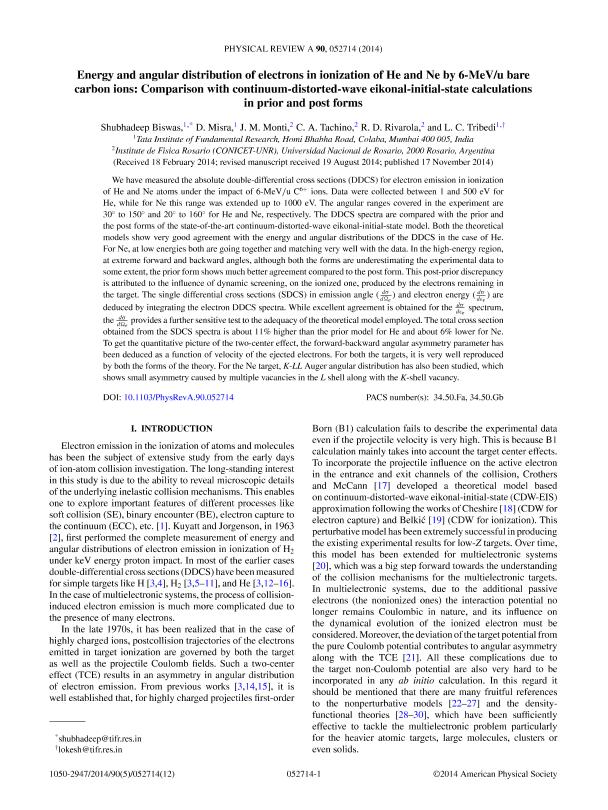Artículo
Energy and angular distribution of electrons in ionization of He and Ne by 6-MeV/u bare carbon ions: Comparison with continuum-distorted-wave eikonal-initial-state calculations in prior and post forms
Biswas, Shubhadeep; Misra, D.; Monti, Juan Manuel ; Tachino, Carmen Alejandra
; Tachino, Carmen Alejandra ; Rivarola, Roberto Daniel
; Rivarola, Roberto Daniel ; Tribedi, L. C.
; Tribedi, L. C.
 ; Tachino, Carmen Alejandra
; Tachino, Carmen Alejandra ; Rivarola, Roberto Daniel
; Rivarola, Roberto Daniel ; Tribedi, L. C.
; Tribedi, L. C.
Fecha de publicación:
11/2014
Editorial:
American Physical Society
Revista:
Physical Review A: Atomic, Molecular and Optical Physics
ISSN:
1050-2947
Idioma:
Inglés
Tipo de recurso:
Artículo publicado
Clasificación temática:
Resumen
We have measured the absolute double-differential cross sections (DDCS) for electron emission in ionization of He and Ne atoms under the impact of 6-MeV/u C6+ ions. Data were collected between 1 and 500 eV for He, while for Ne this range was extended up to 1000 eV. The angular ranges covered in the experiment are 30∘ to 150∘ and 20∘ to 160∘ for He and Ne, respectively. The DDCS spectra are compared with the prior and the post forms of the state-of-the-art continuum-distorted-wave eikonal-initial-state model. Both the theoretical models show very good agreement with the energy and angular distributions of the DDCS in the case of He. For Ne, at low energies both are going together and matching very well with the data. In the high-energy region, at extreme forward and backward angles, although both the forms are underestimating the experimental data to some extent, the prior form shows much better agreement compared to the post form. This post-prior discrepancy is attributed to the influence of dynamic screening, on the ionized one, produced by the electrons remaining in the target. The single differential cross sections (SDCS) in emission angle (dσdΩe) and electron energy (dσdεe) are deduced by integrating the electron DDCS spectra. While excellent agreement is obtained for the dσdεe spectrum, the dσdΩe provides a further sensitive test to the adequacy of the theoretical model employed. The total cross section obtained from the SDCS spectra is about 11% higher than the prior model for He and about 6% lower for Ne. To get the quantitative picture of the two-center effect, the forward-backward angular asymmetry parameter has been deduced as a function of velocity of the ejected electrons. For both the targets, it is very well reproduced by both the forms of the theory. For the Ne target, K-LL Auger angular distribution has also been studied, which shows small asymmetry caused by multiple vacancies in the L shell along with the K-shell vacancy.
Palabras clave:
Energy
,
Angular
,
Distribution
,
Ionization
,
Distorted-Wave
,
Bare-Ions
Archivos asociados
Licencia
Identificadores
Colecciones
Articulos(IFIR)
Articulos de INST.DE FISICA DE ROSARIO (I)
Articulos de INST.DE FISICA DE ROSARIO (I)
Citación
Biswas, Shubhadeep; Misra, D.; Monti, Juan Manuel; Tachino, Carmen Alejandra; Rivarola, Roberto Daniel; et al.; Energy and angular distribution of electrons in ionization of He and Ne by 6-MeV/u bare carbon ions: Comparison with continuum-distorted-wave eikonal-initial-state calculations in prior and post forms; American Physical Society; Physical Review A: Atomic, Molecular and Optical Physics; 90; 5; 11-2014; 52714-52714
Compartir
Altmétricas



